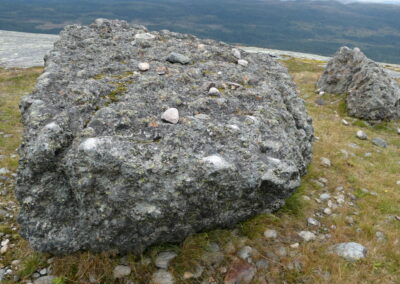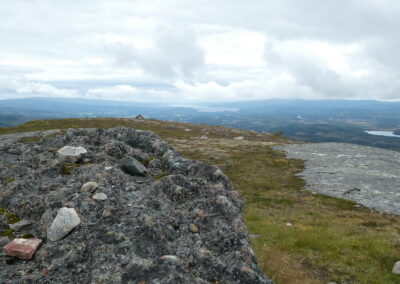The ringing stone at Andorfjellet
Type: Ringing stone
Local name: Klokksteinen
Locality
County: Trøndelag
Municipality: Snåsa
Location: Andorfjellet, /Limannvegen/Prestvegen/Prestestien
The stone is located along Gressåmostien, about 2 kilometers east of Blomlia. After the path crosses the tree line, there is about 1.5 kilometers up to a ridge where the stone is located—at 610 meters above sea level.You will find it next to the path, at a point where the path turns in a southeasterly direction.
Description
The ringing stone is box-shaped—flat at the top, rectangular, and with straight sides. The length is 3 meters, the width 2.5 m and the height about 1 m (90–120 cm). This is a glacial erratic that was tranported with the ice from the east, and the conglomerate structure is completely different from the solid rock in the area. The surface structure is very uneven, with lumps and pits all over. It is earthly, and all around and on the upper side of it there are a lot of smaller stones. In addition, there are two other similar, but smaller rock formations close by. The largest of these, one meter away on the north side, protrudes from the earth as a triangular ridge, measuring 1.5 x 1 meter, with a maximum height of 80 cm. It has sound, like the main stone (see last part of video)
The sound in the stone is not particularly strong or clear, and can be described as deep and metallic. The best sound is at the top of the short side facing south–southeast. There are two frequencies in this area, depending on where you turn. There are no typical cup marks or other traces of people playing on it, and this is probably due to the special, uneven surface structure.
Cultural history and tradition
Klokksteinen is found along Gressåmostien, which was an old road over the mountain, between Agle in Snåsa and Gressåmoen in Lierne. The road was also called Limannvegen, or Prestvegen/Preststien, because the priest used it, on the way between the churches in Snåsa and Lierne. In Lierne there was an annex church under Snåsa until 1873. How far back this route goes is uncertain. This was a footpath, where people hiked or went by horse.
Those who passed Klokksteinen threw smaller stones at it, as a wish of happiness on the journey. It thus became a varp—a sacrificial throw, like hermes in Greek tradition, which means that travelers in certain places stopped and threw stones, coins or other small objects, as a kind of sacrificial act, in order to mark an event, or to pray for happiness on the journey. In this case, it was of course Klokksteinen who made people stop, hit the stone for the sake of sound, and at the same time throw away the small stones they had used. This is something that the Swedish archaeologist Maja Hultman has pointed out in her research on ringing stones in Sweden, where many stones are located in Bronze Age contexts and in proximity to ancient traffic arteries. She has suggested that these stones may have had a function as places where people made ritual acts; that people stopped and made a sound as a wish for happiness for the journey.
People in the local community know about Klokksteinen, and Snåsa ungdomslag (Snåsa ‘youth society’) arranges the annual Gressåmo march which follows Gressåmostien and thus passes Klokksteinen. In his book Andorhistorier. Trolleventyr frå Snåsafjella [Andor tales. Troll fairytales from the Snåsa mountains) Gunnar Viem gives his own supernatural explanation of how Klokksteinen ended up where it is today. It is about the troll Andor who wanted to have a door bell—a nice one, like the one of the trolls of Blåfjella. Andor was told where he could find a stone with sound. In the end he managed to find one—a boulder which was very heavy, but which he succeded to carry and bring home. When he arrived at his place in the Andorfjellet, it turned out that his wife was dissatisfied. She did not want a new-fashioned invention like a door bell. She said that the trolls could continue to bang their gate, as they had always done. Thus she threw the stone down the mountainside, and it remained where it is today.
Sources: Snåsa fjellstyre, Ola Vedal, Gunnar Viem, Johan Storm Nielsen and the book Andorhistorier. Trolleventyr frå Snåsafjella (Gunnar Viem forlag, 2017).





